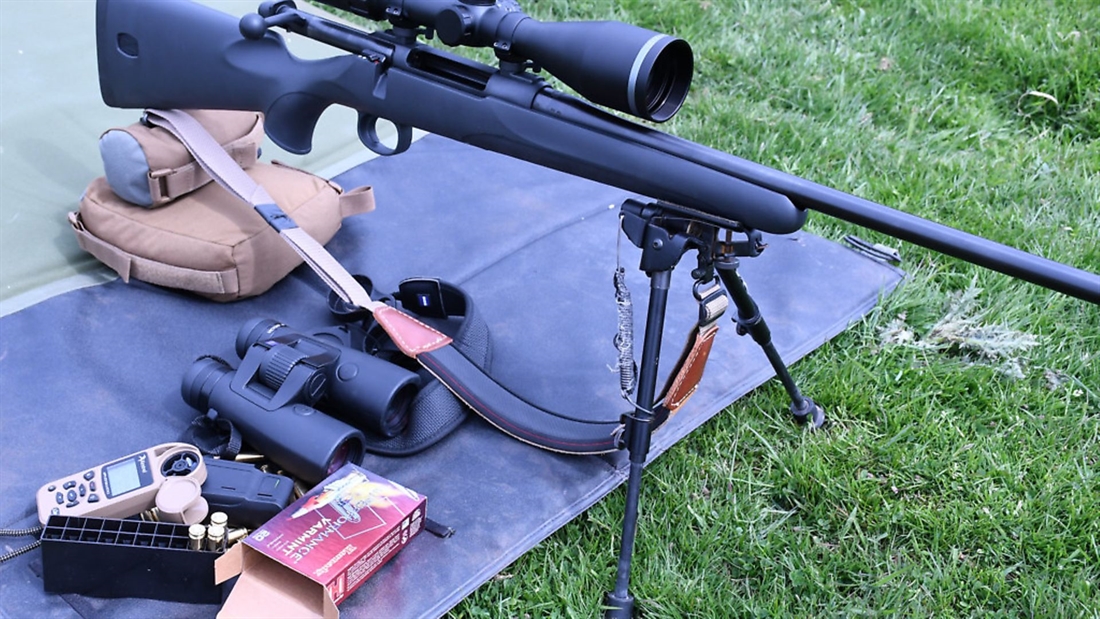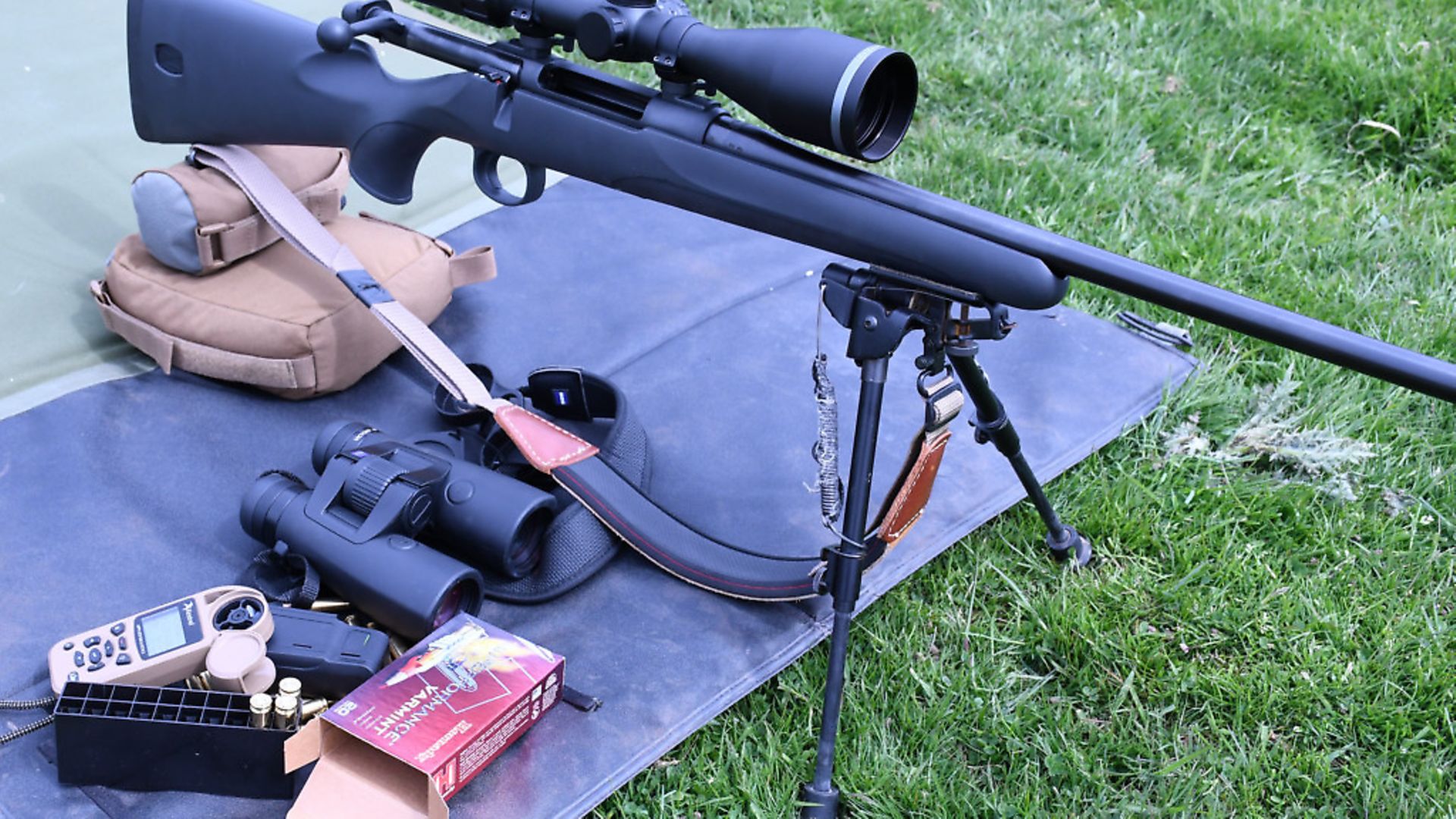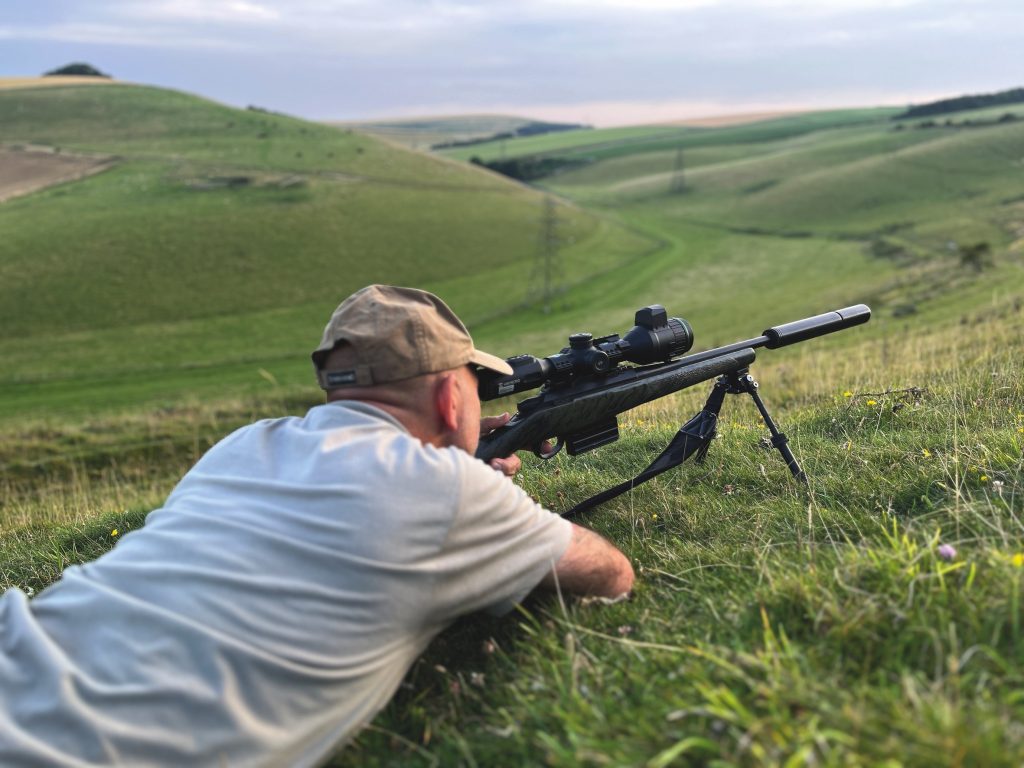Minox ZE5.2 3-15×56 – test and review

Chris Parkin tests the Minox ZE5 3-15×56 hunting riflescope and finds it delivers value for money far beyond his expectations
FOR: Excellent image quality and mechanics; Value for money beyond my expectations; Timeless neat finishing and ergonomic design; Accessible eye box
AGAINST: Absolutely nothing
VERDICT: Take a look at this optic from Minox, it is impossible to ignore in any of its specification options
TECH SPECS
Magnification: 3-15x
Objective diameter: 56 mm
Exit pupil low/high magnification: 11.4/3.8 mm
Field of view low/high magnification: 11.9/2.3 m
at 100 m
Eye relief: ~100 mm
Dioptre adjustment: -3 / +2.5
Elevation / Windage adjustment: ±5.5 mRad (55cm at 100 metres)
Reticle adjustment per click: 1 cm/100 m
Parallax adjustment: 50 m to ?
Reticle illumination: Yes
Reticle: #4
Focal plane: 2nd
Power supply: CR 2032 battery
Holder for 2nd battery: Yes
Argon gas purged: Yes
Fogproof and Waterproof: Yes
Tube diameter: 30 mm
Length: 372 mm
Weight: 760 g
Price: £1,179
Contact: MINOX, 01494 481004 or via www.minox.com for further information
IN DEPTH
The latest ZE5.2 range of hunting scopes from Minox adopt new, innovative solutions to day-to-day needs with the added credentials of having been manufactured in Germany.
Four models with similar 5x zoom range cover most sporting requirements. These include a 1-5×24 for driven game, 2-10×50 for compact daylight hunting needs, the 3-15×56 tested here (likely to be the most appealing to all light condition capabilities that UK laws allow) and a 5-25×56 for recreational target and varmint shooters who desire high magnification.
Once unboxed and fitted to the rifle, each scope is supplied with a heavy-duty neoprene stretch-fit cover that I especially like as it protects all the dials and external surfaces when you slot it into the cabinet, as well as from bumps and tumbles in transit.
Unslipping this reveals the expected sleek, black, hard anodised aluminium tube with a discreet tungsten coloured band around the 56mm objective lens body, to highlight its membership of Minox’s premium ZE5.2 range’s ‘made in Germany’ club. All metalwork is impeccably finished and does not drag all the skin dust from your hands when touched. Water is easily shed and surface debris, such as blood and mud, is wiped off without residue.
The objective lens is recessed 20mm within the protective aluminium body for better clarity and lesser chance of any reflections spooking game, as well as minimising the chances of an errant branch or stone wall being able to leave its mark on the glassware within. None of the flashy greens or reds are visible on the lens coatings, just a deep, dark black inside that indicates little reflected light being wasted at the doorway to the optic.
Capped windage and elevation dials at the saddle give fingertip alterations when zeroing, with 1cm @ 100m clicks being the simplest and most logical unit to work with. Each cap is machined aluminium with segmented knurling on the external profile for grip that matches the zoom ring further to the rear. It’s a good compromise in size too: 32mm diameter and 15mm tall to remain uncluttered and accessible when wearing gloves too.
Each inner dial offers 60 strongly detented clicks per turn which offers fumble-free control, and these can be loosened and spun back to indicate zero point on their marking once set-up is completed.
They are broadly set into groups of 10 clicks and total adjustment gives 55cm of travel at 100m. Not the largest quantity on the market in a hunting optic but indicative of the internal erector tube’s size relative to the 30mm body of the external tube.
This is the tube where the cross-sectional area of the lenses equates to light transmission through to your eyes, and size does matter, so this compromise is what I would call a positive element of the device’s functionality.
We all know the vast amount of elevation that a cheaply manufactured 1” tubed optic gives, yet how poor the light transmission and image quality are! They are a perfect example of the opposing logic for scopes designed for use on cheap, badly aligned rifles and scope mounting systems.
I really like the ZX range from Minox, but its one fault, in my opinion, is an uneven 7½ MOA per turn of the dial. Neither that, nor the ZE5.2, are dialling scopes for long-range shooters, but this simpler 60 clicks per turn (6mRad adjustment) is more pure and logical with less chance of a mistake.
Parallax and illumination are shown to the left side of the saddle with the former operating down below 50m for perhaps better suitability on a rimfire rifle, yet without compromise when it still goes all the way out to infinity with no backlash for a sharp picture of the target or quarry. I tend to leave a hunting optic set around 200m and forget it unless specifically needed, but the feature is there for you to choose. It mainly comes into its own as distance decreases and magnification increases. Parallax is a constant factor, but not always noticed and, guess what, if the brain doesn’t worry about it, you don’t tend to make mistakes if you understand where and when it is a significant factor.
Illumination is controlled by the outer dial to the saddle’s left side with a smooth power increase that’s marked from 0-8 on its rim. This illuminates a very small fibre-optic central dot on the German 4 reticle within and now features an automatic ‘off’ when the rifle is laid on its side for two hours.
This is a great update to compete with optics at twice the price and makes life so much simpler in the modern electronic world where scope batteries are now a permanent accessory within my field kit. The Minox isn’t going to eat them up like non-automated units and there is a space for a spare inside the dial cap.
The assembly is perhaps a little bulkier than some, projecting 30mm out from the 30mm scope tube, but it’s certainly not as ungainly as some supposed hunting scopes whose dials are like top hats.
The reticle is in the second focal plane so remains constantly slender throughout the zoom range and at low mag. Having a quickly controllable, extremely fine red dot available in the centre, enjoying an intensity of your choice, is the perfect accessory to broaden capability in any light or background.
Etched reticles can be made so finely that at low mag in woodland they easily vanish, but not with a dull red glow to draw your focus central and enjoy a spacious uncluttered field of view at 3x or 4x magnification without destroying your night vision.
It goes without saying that regardless of brightness, there is no unwanted sparkling or dazzling shimmer of red light reflected from bleeding intensity elsewhere in the sight picture, and Minox have done a great job here with good ergonomics and usability on the external controls and internal electronics.
Moving to the optical performance, we are entering the price point where differentiating capability is measured in singular minutes at dusk. Minox name their multi coating system M*, which is nice, but like all the top optical houses, no secrets are revealed in a name other than a specification of full multi coatings, argon inert gas tube fill and outstanding light transmission.
They don’t publish an exact figure and, no, it’s not quite as bright as optics twice its price, but it is very nice to look and aim through with sharp edge-to-edge clarity and well defined reticle easily focused with the rear eyepiece on the newly designed FTA (Fast Target Acquisition) ocular body.
Colours are bright and well defined with good contrast until darkness and, importantly, no eye strain for a relaxed viewing environment. The FTA system is a moniker for the system employing a slightly larger ocular body of 45mm diameter, shrouding the 38mm lens for a wider field of view. This broadens access to the eyebox without vignetting to enable a more fluid gun mount and point on target, without ‘searching’ for a tiny exit pupil that is itself hidden within a minute focal point.
Although recoil is hardly significant on a .243, there is enough jump to unsettle the gun and I found re-acquiring the correct head and eye position in the split second needed to reset aim on the rifle after a shot was faster, with better ability to see where the bullet was landing and gauge immediate post-impact reactions on game.
Scopes with too much magnification and small eyeboxes are a pain to do this with and, although we are talking fractions of a second, it is wearing and tedious. It may mean losing sight picture on a deer that has been caught badly and bolted into cover, meaning you’re unable to see its immediate direction, or on a long day varminting, generally degrading eye strain from the repetitive exercise of the ciliary muscles and strained neck muscles.
No, the ZE5.2 gives that almost indefinable comfort in use from any shooting position with eye relief never really becoming noticeable when swapping from head-forward, prone shots to more relaxed and intuitive low-magnification standing shots, especially on moving targets. I can’t state any data on this, but Minox have made the image easily accessible with great mechanics to back it up.
I gave the scope’s dials a thorough workout tackling some longer steel targets and rabbits on my regular moorland testing ground with shots as far as 650m. Mechanical adjustments were tactile and returned to zero each time with a reliable box test that performed cleanly.
As before, it’s not a fast dialling scope, but surety of its mechanical capability means on those days you want to change ammo or flip between a point zero at 50 or 100m, to the following months in Scotland where a 200m point blank zero would be preferable, you can do this without fear of the internals letting you down.
Knowing I can alter a scope whenever I want to, without time- and ammunition-consuming zeroing sessions, is invaluable. Likewise, the magnification zoom ring at the front of the ocular body offers smooth movement with no internal noise from helical assemblies shifting the lens packages about, and none of the dreaded sponginess at either end of travel – just understated binary feel of a dead stop when travel limits are reached.
I have an endless turnover of shooting tackle and for me to get out and shoot for my own pleasure with kit I know is set up perfectly and trusted is sometimes a novelty, but, thankfully, this scope has been with a .243 Mauser M18 for several months now.
Any phone call to get out, mainly for local foxes, has seen me pick up this rifle and go without doubt. Most of my fox shooting is ambush work so I get to sit out, relax and wait as darkness approaches while watching the colours fade together before gloom envelopes, when silhouettes are all that is left. The time between these two stages is what really means the most to me, so when optical performance exceeds expectations and mechanical usability is tallied alongside, I find it hard not to be pleased. I cannot mark out a single fault or dislike I have for this Minox and that is very rare – I can always usually find something I don’t like with any product.
Related Articles
Get the latest news delivered direct to your door
Subscribe to Rifle Shooter
Elevate your shooting experience with a subscription to Rifle Shooter magazine, the UK’s premier publication for dedicated rifle enthusiasts.
Whether you’re a seasoned shot or new to the sport, Rifle Shooter delivers expert insights, in-depth gear reviews and invaluable techniques to enhance your skills. Each bi-monthly issue brings you the latest in deer stalking, foxing, long-range shooting, and international hunting adventures, all crafted by leading experts from Britain and around the world.
By subscribing, you’ll not only save on the retail price but also gain exclusive access to £2 million Public Liability Insurance, covering recreational and professional use of shotguns, rifles, and airguns.
Don’t miss out on the opportunity to join a community of passionate shooters and stay at the forefront of rifle technology and technique.





